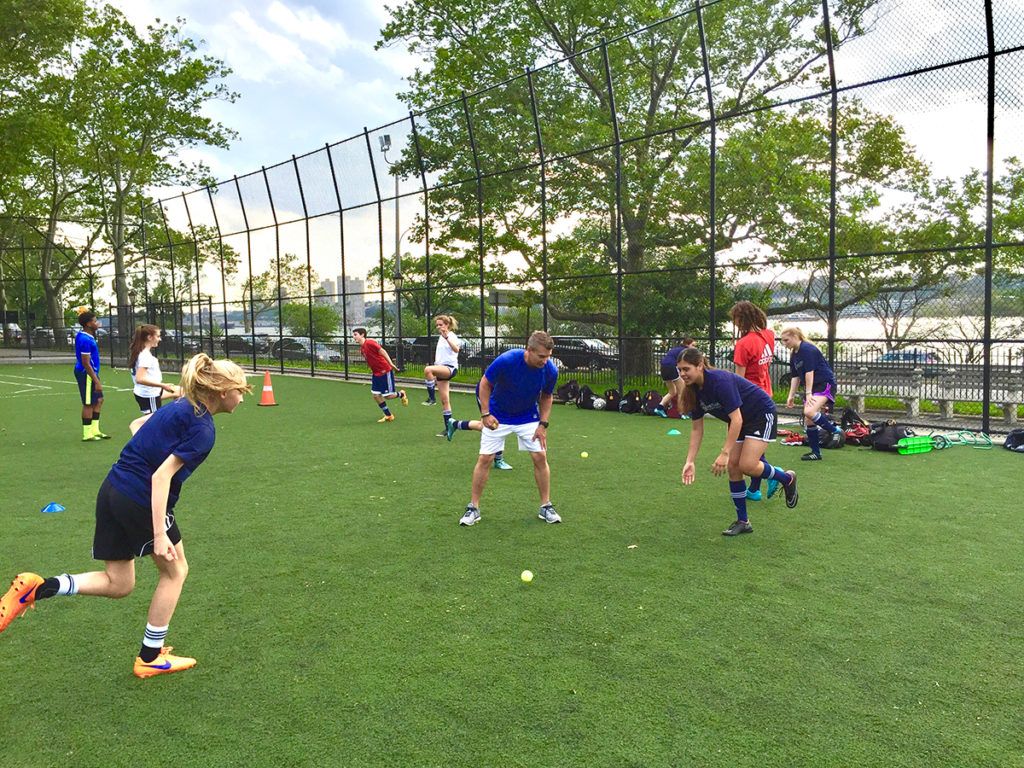By Scott Lancaster and Luis Fernando Llosa

1. Strengthen the Correct Muscles
Too many trainers fail to train female athletes correctly.
Their training programs focus on the front of the body:
• thighs
• chest
• abdominals
They neglect the back half of the body:
• glutes
• hamstrings
• back
• calves
Female athletes should not be trained like their male counterparts. Their workouts should focus on improving range-of-motion and strengthening specific muscle groups—like glutes and hamstrings—during pre-season. What’s more, keeping up with such training throughout the regular season can dramatically reduce the risk of ACL injuries.
To be more specific, one of the major causes of female
athletes injuries is the overdevelopment of their quadriceps—the large muscle
group on the front of the thighs. This over-strengthening typically translates
into weaker hamstrings—the large muscle group on the back of the thighs. The
result: instability in their knees when decelerating, rapidly changing
direction or landing from a jump. This heightens the probability of a ACL
injury when practicing or competing.
One of the most effective hamstring strengthening
exercises is the Nordic Hamstring Exercise. This exercise not only develops the
hamstring, but also decreases hamstring injury rates by 60%, and reoccurrence
by 85% (A. Arnason – 2008, University of Iceland – Department of
Physiotherapy).
2. Learn Proper Movement Techniques
As an athletic performance specialist Scott Lancaster trains female athletes daily in Fairfield County, Connecticut and New York City. He specializes in movement and speed training. And one of the key things he emphasizes is proper movement technique.
If you don’t move correctly you won’t be able to perform your sport-specific skills with optimal success. And, more critically, if you don’t use proper movement techniques you can greatly increase your risk of serious injuries like ACL tears.
The 3 key movement techniques are:
- Running Form
- Deceleration
- Jumping and Landing
A) Running Form – Running is most important athletic movement that most athletes need to master. Yet we pay little to no attention to practicing and/or instructing athletes on the proper way to run. Proper running form improves speed, agility, and dynamic balance, and reduces the likelihood of many injuries. It is one of the most essential skills needed to reach optimal performance.
B) Deceleration – Learning to slow down and stop is a skill that is essential not only to an athlete’s improved performance but also for injury prevention. Many sports require an athlete to slow down and stop repeatedly during the flow of competition.
Deceleration also plays a vital role in change-of-direction movement. Slowing down properly in order to accelerate again is critical to running a proper route when making cuts or runs in field hockey and lacrosse, transitioning from offense to defense in soccer or drop stepping before driving to the basket in basketball.
A majority of knee injuries do not involve contact. They are a result of improperly executed deceleration. When an athlete slows down or stops improperly, she is often upright and in a straight leg position. This posture is dangerously unstable.
C) Jumping & Landing – This essential skill seems so basic, but is often not practiced or taught. Improperly executed jumping and landing not only limits performance, but is a recipe for injury-disaster.
Many athletes injure their ACL when landing incorrectly. This can be a result of hip instability—in addition to weak hamstrings and glutes—as we mentioned above. An athlete who lands knock-kneed (an internal rotation of the knee) is vulnerable to an ACL injury.
3. In-Season Injury-Prevention Training
Injury prevention is often not properly addressed at all by coaches and trainers. But when it is, focus is typically placed only on pre-season workouts. That’s not enough. Injury prevention training should be conducted throughout the season, especially because the body begins to fatigue as a season progresses. Stabilizing muscles begin to weaken and movement skills can begin to deteriorate.
Proper training can really help prevent injuries:
For the past 2 years we have incorporated a consistent series of injury-prevention and movement-skill training programs throughout the pre-season and regular season with the top-ranked high school field hockey program in the state of Connecticut. Over this period there have been no lower limb injuries. This is after a rash of ACL injuries occurred throughout prior seasons.
We recommend single leg balance and strengthening exercises be conducted at every practice: at least 3 to 5 times per week.
Now is the time to train female athletes differently. We can develop strong, healthy young female athletes at a proper pace and with appropriate movement and strengthening techniques, so that they stay healthy and truly enjoy competitive sports while performing to their utmost potential in sports and beyond. ♦
Scott Lancaster is an Athletic Performance Expert (www.championsofspeed.com) and the founder of Trick it Out Sports (www.trickitoutsports.com), a series of sports-specific apps that gamify age appropriate fundamental skill training—utilizing customized skill challenges that track and rank an athlete’s individual development.
Luis Fernando Llosa is a sports writer, investigative reporter, documentarian and youth sports safety advocate (www.luisfernandollosa.com).
Scott and Luis Fernando co-founded Whole Child Sports (www.wholechildsports.com) with parenting expert Kim John Payne. The three co-authored Beyond Winning: Smart Parenting in a Toxic Sports Environment.